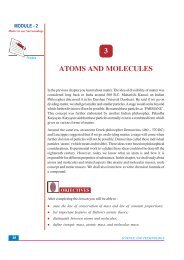NIOS : The Way Forward - The National Institute of Open Schooling
NIOS : The Way Forward - The National Institute of Open Schooling
NIOS : The Way Forward - The National Institute of Open Schooling
You also want an ePaper? Increase the reach of your titles
YUMPU automatically turns print PDFs into web optimized ePapers that Google loves.
34 / <strong>NIOS</strong>: <strong>The</strong> <strong>Way</strong> <strong>Forward</strong><br />
It would be wrong to assume that all educational objectives (cognitive, affective,<br />
and psychomotor) can be taken care <strong>of</strong> by study materials alone. When it<br />
comes to practical work, or to the development <strong>of</strong> social skills and life skills,<br />
study materials need to be supplemented by contact programmes, and through<br />
well designed experiences and reflection. <strong>The</strong> availability <strong>of</strong> tutors and teachers<br />
as mentors who are ready to accompany the students in their learning<br />
experiences is a major support system to holistic learning and development in<br />
the ODL as in the formal system.<br />
4.3 Regional Centres and Study Centres<br />
<strong>NIOS</strong> has set up 11 regional Centres in different parts <strong>of</strong> the country. <strong>The</strong><br />
Regional Centres are located in Allahabad, Bhopal, Chandigarh, Delhi,<br />
Guwahati, Hyderabad, Jaipur, Kochi, Kolkata, Patna and Pune. Under each,<br />
the Accredited <strong>Institute</strong>s serve as study centres. Currently, they total 3286.<br />
<strong>The</strong>se include 1085 Accredited Vocational Education <strong>Institute</strong>s. With the aim<br />
to reduce or eliminate distance and to provide quick information and support<br />
to the learner, these regional centres and study centres act as information<br />
centres, resource consultation centres and tutorial and counselling centres.<br />
4.4 Personal Contact Programmes (PCP)<br />
Even though the learners are located at great distances from the headquarters,<br />
the learners have to maintain some degree <strong>of</strong> contact with the teacher, besides<br />
the print and audio or video contacts. Mentoring and accompaniment are<br />
non-negotiable components in any effective process <strong>of</strong> learning, especially in<br />
the formative years. This is also true, when one deals with learners, who had<br />
experienced a great deal <strong>of</strong> failure or deprivation and are hoping to get a<br />
second chance access to life through a second chance education. Such students<br />
need this teacher accompaniment. <strong>The</strong> quality <strong>of</strong> this relationship, this rista,<br />
makes a great difference in the ODL. As regards budgeting <strong>of</strong> time during<br />
contact programmes, sixty percent <strong>of</strong> time should be devoted to solving<br />
individual problems or on tutorials. In the remaining time, students can be<br />
provided teaching <strong>of</strong> basic concepts. A small gap in understanding <strong>of</strong> basic<br />
concepts results in wider disparities <strong>of</strong> student’s performance later on.<br />
4.5 Mind Maps<br />
<strong>NIOS</strong> had developed Mind Maps or concept Maps to help the students to<br />
understand the topic <strong>of</strong> a whole chapter better, by seeing all the connections<br />
and sub-connections and how each is linked to the other, namely their interdependence.<br />
Like a spider’s web, the Mind Map has major anchor lines and<br />
sub-lines attached to these. MM demonstrates a pathway to better learning. It<br />
will help answer the questions: what comes before and what comes after;<br />
what is the cause and what is the effect; what is the principle and what are the<br />
applications etc. It is as much a teaching help to the teacher as it is a learning<br />
help to the learner. <strong>The</strong> entire course can be presented as a summary Mind<br />
Map, which gives them a holistic perspective or bird’s eye view <strong>of</strong> the whole<br />
course. Similarly, one topic can also be put as a Mind Map. When undertaken

















